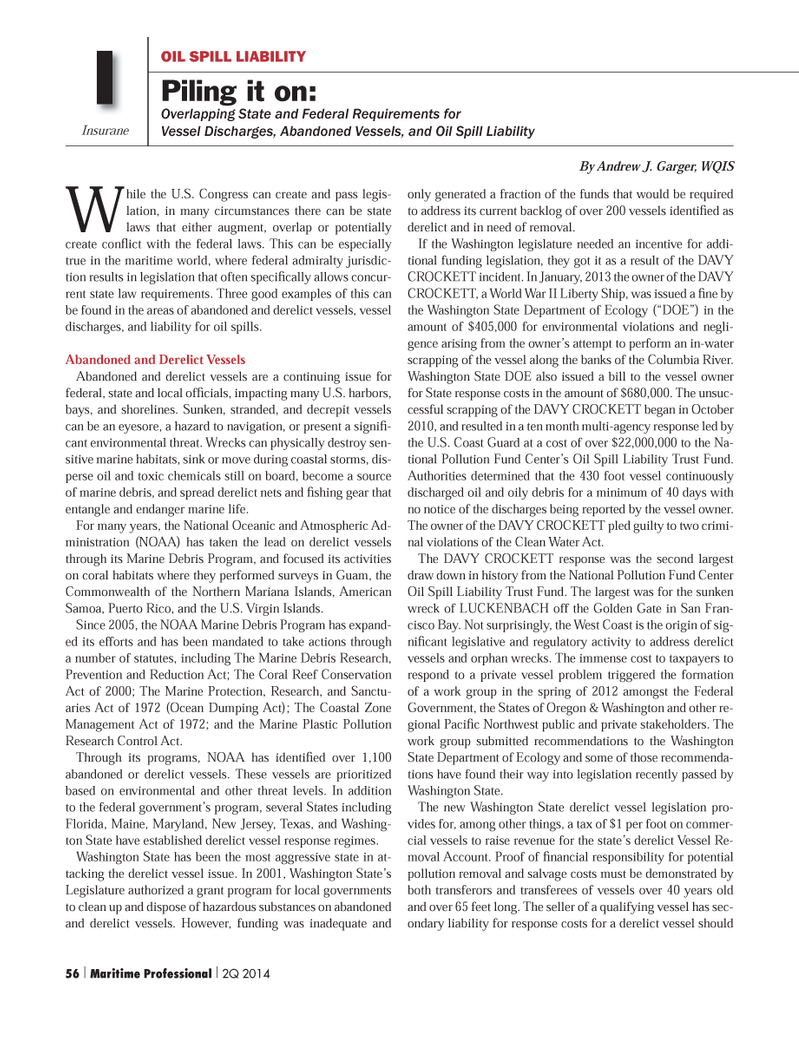
Page 56: of Maritime Logistics Professional Magazine (Q2 2014)
Maritime Risk & Shipping Finance
Read this page in Pdf, Flash or Html5 edition of Q2 2014 Maritime Logistics Professional Magazine
Insurane
OIL SPILL LIABILITY
Piling it on:
Overlapping State and Federal Requirements for
Vessel Discharges, Abandoned Vessels, and Oil Spill Liability
I
By Andrew J. Garger, WQIS
W hile the U.S. Congress can create and pass legis- lation, in many circumstances there can be state laws that either augment, overlap or potentially create confl ict with the federal laws. This can be especially true in the maritime world, where federal admiralty jurisdic- tion results in legislation that often specifi cally allows concur- rent state law requirements. Three good examples of this can be found in the areas of abandoned and derelict vessels, vessel discharges, and liability for oil spills.
Abandoned and Derelict Vessels
Abandoned and derelict vessels are a continuing issue for federal, state and local offi cials, impacting many U.S. harbors, bays, and shorelines. Sunken, stranded, and decrepit vessels can be an eyesore, a hazard to navigation, or present a signifi - cant environmental threat. Wrecks can physically destroy sen- sitive marine habitats, sink or move during coastal storms, dis- perse oil and toxic chemicals still on board, become a source of marine debris, and spread derelict nets and fi shing gear that entangle and endanger marine life.
For many years, the National Oceanic and Atmospheric Ad- ministration (NOAA) has taken the lead on derelict vessels through its Marine Debris Program, and focused its activities on coral habitats where they performed surveys in Guam, the
Commonwealth of the Northern Mariana Islands, American
Samoa, Puerto Rico, and the U.S. Virgin Islands.
Since 2005, the NOAA Marine Debris Program has expand- ed its efforts and has been mandated to take actions through a number of statutes, including The Marine Debris Research,
Prevention and Reduction Act; The Coral Reef Conservation
Act of 2000; The Marine Protection, Research, and Sanctu- aries Act of 1972 (Ocean Dumping Act); The Coastal Zone
Management Act of 1972; and the Marine Plastic Pollution
Research Control Act.
Through its programs, NOAA has identifi ed over 1,100 abandoned or derelict vessels. These vessels are prioritized based on environmental and other threat levels. In addition to the federal government’s program, several States including
Florida, Maine, Maryland, New Jersey, Texas, and Washing- ton State have established derelict vessel response regimes.
Washington State has been the most aggressive state in at- tacking the derelict vessel issue. In 2001, Washington State’s
Legislature authorized a grant program for local governments to clean up and dispose of hazardous substances on abandoned and derelict vessels. However, funding was inadequate and only generated a fraction of the funds that would be required to address its current backlog of over 200 vessels identifi ed as derelict and in need of removal.
If the Washington legislature needed an incentive for addi- tional funding legislation, they got it as a result of the DAVY
CROCKETT incident. In January, 2013 the owner of the DAVY
CROCKETT, a World War II Liberty Ship, was issued a fi ne by the Washington State Department of Ecology (“DOE”) in the amount of $405,000 for environmental violations and negli- gence arising from the owner’s attempt to perform an in-water scrapping of the vessel along the banks of the Columbia River.
Washington State DOE also issued a bill to the vessel owner for State response costs in the amount of $680,000. The unsuc- cessful scrapping of the DAVY CROCKETT began in October 2010, and resulted in a ten month multi-agency response led by the U.S. Coast Guard at a cost of over $22,000,000 to the Na- tional Pollution Fund Center’s Oil Spill Liability Trust Fund.
Authorities determined that the 430 foot vessel continuously discharged oil and oily debris for a minimum of 40 days with no notice of the discharges being reported by the vessel owner.
The owner of the DAVY CROCKETT pled guilty to two crimi- nal violations of the Clean Water Act.
The DAVY CROCKETT response was the second largest draw down in history from the National Pollution Fund Center
Oil Spill Liability Trust Fund. The largest was for the sunken wreck of LUCKENBACH off the Golden Gate in San Fran- cisco Bay. Not surprisingly, the West Coast is the origin of sig- nifi cant legislative and regulatory activity to address derelict vessels and orphan wrecks. The immense cost to taxpayers to respond to a private vessel problem triggered the formation of a work group in the spring of 2012 amongst the Federal
Government, the States of Oregon & Washington and other re- gional Pacifi c Northwest public and private stakeholders. The work group submitted recommendations to the Washington
State Department of Ecology and some of those recommenda- tions have found their way into legislation recently passed by
Washington State.
The new Washington State derelict vessel legislation pro- vides for, among other things, a tax of $1 per foot on commer- cial vessels to raise revenue for the state’s derelict Vessel Re- moval Account. Proof of fi nancial responsibility for potential pollution removal and salvage costs must be demonstrated by both transferors and transferees of vessels over 40 years old and over 65 feet long. The seller of a qualifying vessel has sec- ondary liability for response costs for a derelict vessel should 56 | Maritime Professional | 2Q 2014 50-63 Q2 MP2014.indd 56 5/16/2014 3:01:39 PM

 55
55

 57
57
